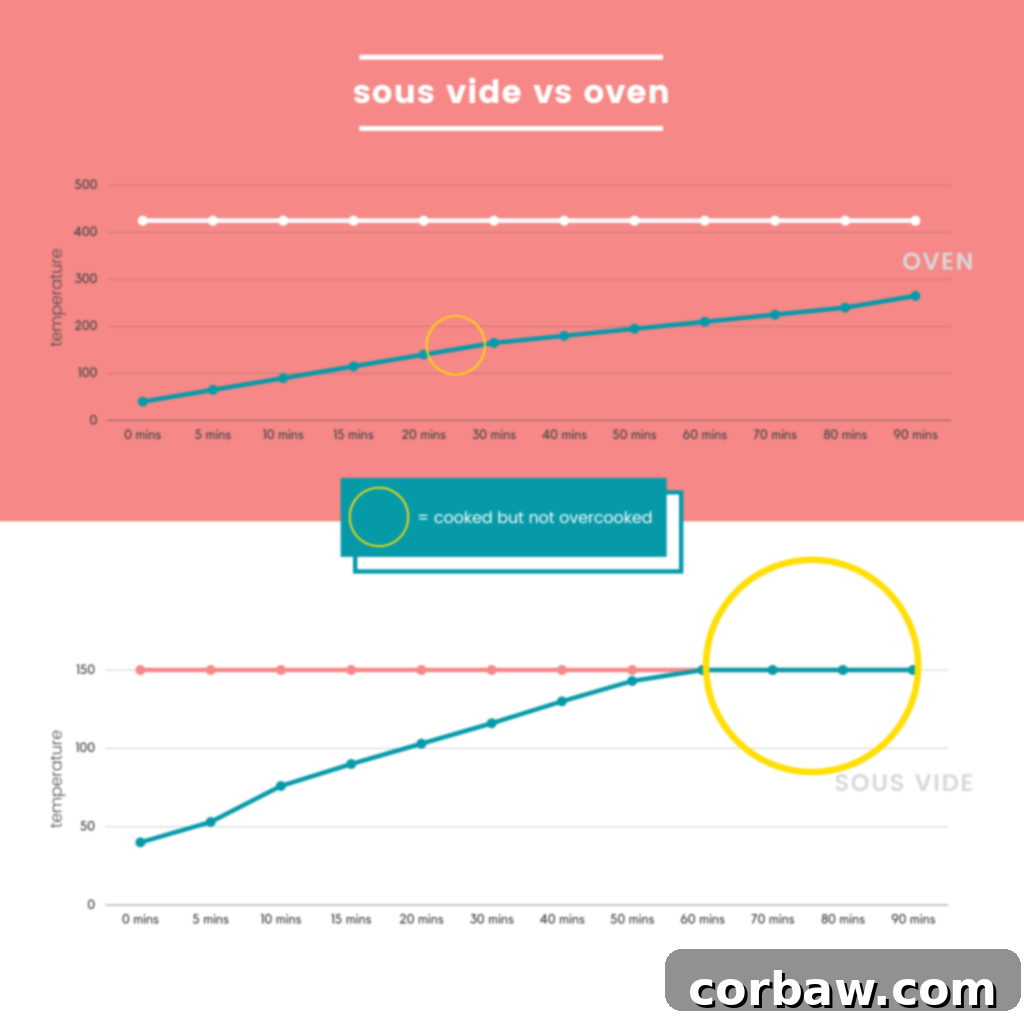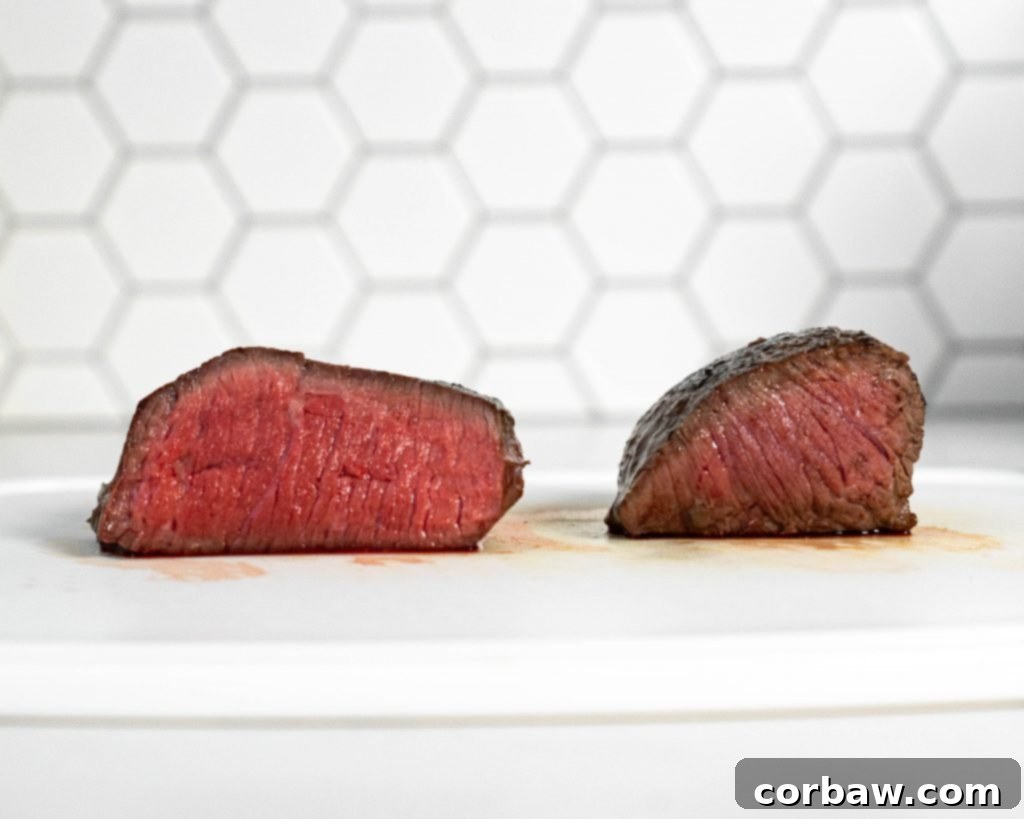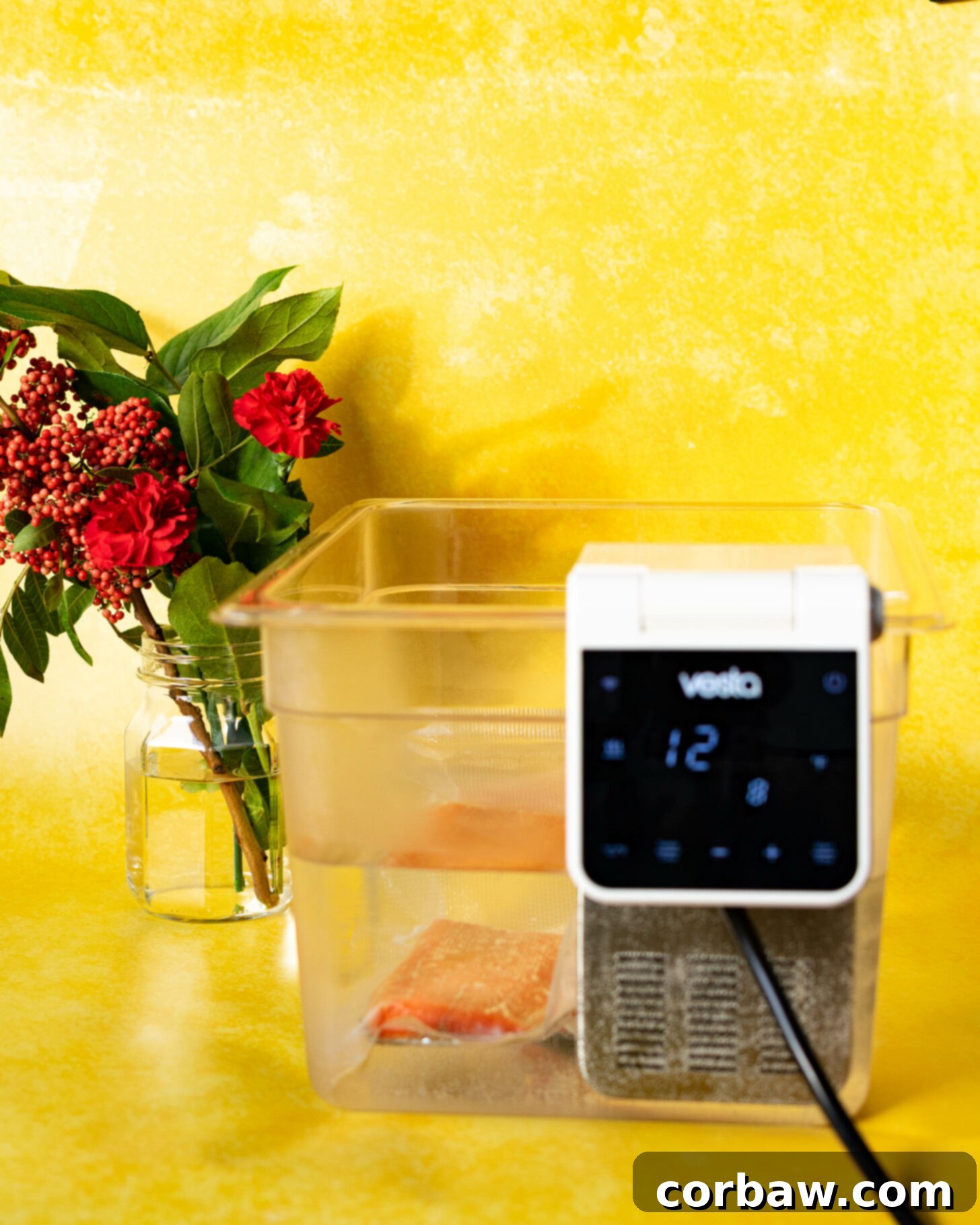Mastering Sous Vide: Your Comprehensive Guide to Precision Cooking at Home
Sous vide, often celebrated as “precision cooking,” is a revolutionary culinary method transforming the way home cooks approach food preparation. While its fame often stems from restaurant-quality dishes like perfectly cooked steak or Starbucks’ renowned Sous Vide Egg Bites, this technique offers an incredible range of applications that extend far beyond gourmet meals. It’s a game-changer for anyone seeking consistently delicious results with minimal effort.
Initially, sous vide might seem like a complex, high-tech endeavor. However, once you grasp the simple science behind it, you’ll discover that it dramatically simplifies cooking, especially for dishes traditionally considered challenging. From delicate fish to tender meats and even perfectly set custards, sous vide removes the guesswork, turning daunting tasks into effortless triumphs.
Why learn about sous vide with me? My culinary journey in food blogging began in 2010, and I’ve been passionately exploring and perfecting sous vide techniques since 2016. Over these years, I’ve amassed a wealth of knowledge and developed dozens of sous vide recipes, all available on this website to guide your culinary adventures. For those eager to delve deeper, you can find even more practical recipes and meal plans in my cookbooks: Everyday Sous Vide and Sous Vide Meal Prep. Additionally, I’ve distilled all essential knowledge for aspiring home cooks into my comprehensive digital guide, Sous Vide School. My core belief is that sous vide has the incredible potential to simplify and enhance the lives of home cooks everywhere. While I occasionally indulge in more elaborate sous vide projects (like sous vide brisket!), my primary focus is always on making everyday cooking more accessible, consistent, and enjoyable for you.
Sous Vide School: Unlock Your Culinary Potential
My interactive guide for beginners is designed to teach you everything you need to know about sous vide cooking. You’ll master delicious dinners, decadent desserts, refreshing drinks, and more, all while significantly saving time and money!
Table of Contents
- How to Pronounce Sous Vide
- What is Sous Vide Cooking?
- How Does Sous Vide Work?
- Can You Overcook Meat in Sous Vide?
- Sous Vide Cooking: Safety & Best Practices
- Understanding Pasteurization
- Choosing Safe Sous Vide Bags
- Is Sous Vide Worth the Investment?
- Essential Sous Vide Equipment for Beginners
- Top Sous Vide Recipes to Get Started
- Further Your Sous Vide Education
How to Pronounce Sous Vide Like a Pro
Don’t worry if you’ve been unsure about how to say this elegant French culinary term! It’s a common stumbling block for many new to the technique. But once you know, you’ll sound like a seasoned chef in no time. So, let’s demystify it:
The correct pronunciation in English is: Soo (rhymes with “moo”) veed. Go ahead, try it out! Now you’re ready to discuss your culinary triumphs with confidence.
What Exactly is Sous Vide Cooking?
Let’s start with the basics. “Sous vide” is a French term that literally translates to “under vacuum.” While the concept of low-and-slow cooking or pressure cooking has roots stretching back centuries, the specific method we know as sous vide cooking today was innovated in France during the 1970s. It revolutionized professional kitchens by offering unparalleled consistency and control.
So, what does this mean for your kitchen? At its core, sous vide cooking involves sealing your food in a food-safe bag (often with the air removed, hence “under vacuum”) or a glass jar, and then immersing it in a precisely temperature-controlled water bath for an extended period. This process ensures consistent cooking heat throughout the entire duration, typically for slightly longer than conventional methods. The beauty lies in its simplicity: food in a bag/jar, bag/jar in a water bath, and then you let it do its magic.
To begin your sous vide journey, you’ll need a container – a simple large stockpot or a dedicated plastic water bath container works perfectly. Into this, you place an immersion circulator. This essential device is the heart of the sous vide system. Just as you’d set a specific temperature for a hot tub, you set your desired cooking temperature on the immersion circulator.
An immersion circulator is what elevates a basic water bath into a highly precise cooking environment, much like a hot tub’s temperature-regulated system. It tirelessly heats and circulates the water, ensuring every part of your food experiences the exact same temperature.
Once activated, the immersion circulator draws water through its heating coils and then pumps it back into the container, creating a constant, uniform temperature. This continuous circulation guarantees that the water bath maintains your exact desired temperature, ensuring your food cooks evenly from edge to center, every single time.
How Does Sous Vide Achieve Perfect Results Every Time?
Let’s consider sous vide steak as a prime example. The desired “doneness” of a steak—whether rare, medium-rare, or well-done—is directly determined by the maximum internal temperature the center of the meat reaches. A rare steak, for instance, is literally cooler at its core than a well-done one.
What is “doneness”? It’s that critical question a server asks at a restaurant: “How would you like your steak cooked?” Your answer, be it “medium-rare, please,” defines the precise internal temperature and resulting texture you desire for your meat.

With sous vide, you set your water bath to the *exact* target temperature for your desired doneness. For a perfect medium-rare steak, I typically set my circulator to 129 degrees F. When a vacuum-sealed steak is placed in this water bath, it can never cook beyond 129 degrees F because the entire cooking environment is maintained at that precise temperature. This fundamental principle is what makes sous vide cooking so revolutionary.
Contrast this with traditional oven or pan cooking. If you’re cooking a steak in an oven set to 425 degrees F, you face the immense challenge of pulling the steak out at that fleeting, precise moment its center reaches 129 degrees F. Miss that window by even a minute or two, and you risk overcooking it. This “magical, unknown moment” introduces significant guesswork and stress.
In a sous vide water bath, this problem vanishes. I could cook that same steak for hours, or even days within safe limits, and it would *still* maintain its perfect medium-rare doneness. This is because the ambient temperature of the water bath dictates the maximum internal temperature the food can reach. You’ve read that correctly: with sous vide, you virtually eliminate the risk of ruining an expensive cut of meat by overcooking it. It’s a level of control unparalleled by conventional cooking methods.

Can You Overcook Meat in Sous Vide? (Doneness vs. Texture)
The short answer is nuanced: While it’s nearly impossible to “overcook” your meat in terms of its internal doneness (e.g., a medium-rare steak will stay medium-rare regardless of extended cooking time, within reasonable limits), you *can* alter its texture through prolonged exposure to heat. This distinction is crucial for mastering sous vide.
One of the most remarkable benefits of sous vide is achieving perfect doneness from edge to edge. Say goodbye to the frustrating rings of varying doneness that often plague traditionally cooked steaks, where only the very center achieves your desired medium-rare. With sous vide, you get that ideal texture and color uniformly throughout the entire cut. The visual difference is striking:
See the photo below: the steak on the left was cooked sous vide, then quickly seared to perfection in a very hot cast iron skillet. Observe its consistent rosy hue. The steak on the right was pan-seared from start to finish, exhibiting the typical gradient of doneness, with a grayer, more cooked outer ring.

However, it’s important to understand that the longer you cook meat sous vide, the more you change its texture. This is due to the breakdown of connective tissues and proteins over time. This tissue breakdown can sometimes be highly desirable! For instance, if you’re working with a tougher cut of meat from the butcher, like a chuck roast, short ribs, or even a pork shoulder, a longer sous vide bath (sometimes for 24-48 hours) will render it incredibly pull-apart tender. Unlike a slow cooker or oven, sous vide achieves this without any risk of drying out the meat, preserving its natural juices and flavor. So, while doneness is fixed, texture can be precisely manipulated by adjusting cooking time.
Sous Vide Cooking: Safety & Best Practices
When executed correctly, sous vide cooking can actually be significantly safer than many traditional cooking methods. The precise temperature control minimizes the risk of undercooking and can even enhance food safety through pasteurization. The most critical safety measure is simple: regularly check your immersion circulator to ensure it’s operating correctly and maintaining the set temperature. Like any electronic device, failures can occur, so vigilance is key.
Understanding Pasteurization with Sous Vide
For those concerned about food safety, especially with meats that aren’t typically cooked “well-done,” sous vide offers a fantastic solution: pasteurization. You can achieve a fully pasteurized medium-rare steak, effectively eliminating harmful bacteria without sacrificing that desirable tender texture. This means germaphobes (like my father-in-law!) no longer need to suffer through dry, well-done steaks to feel safe. Pasteurization in sous vide is achieved by cooking food at 130 degrees F (54.4°C) or higher, ensuring the food remains at or above that temperature for a specified duration.
A frequently asked question arises when discussing sous vide chicken: “Why can I cook sous vide chicken at temperatures lower than the universally recommended 165 degrees F (74°C)?” We’ve all been taught that 165°F is the magic number for poultry safety!
The truth is, while 165°F guarantees instant pasteurization, it’s not the full story. Food safety guidelines from experts like the USDA often simplify complex information for broad understanding, which is commendable. However, pasteurization is intrinsically linked to *both* time and temperature.
The goal of cooking chicken to 165°F is to kill harmful bacteria, primarily salmonella. This process is called pasteurization. Pasteurization is not just about reaching a certain temperature, but also about maintaining that temperature (or a slightly lower one) for a sufficient amount of time.
The reason 165°F is the “gold standard” is because at this temperature, chicken is instantly pasteurized. However, at lower temperatures, bacteria are still effectively eliminated, it just takes a bit longer. For example, the lowest temperature I recommend for cooking chicken is 140 degrees F (60°C). If your chicken reaches and holds an internal temperature of 140 degrees F all the way through for at least 27.5 minutes, it will be thoroughly pasteurized! To be safe and account for varying thickness and initial temperatures, I typically recommend a minimum of 2 hours for chicken at this temperature, ensuring ample time for the food to reach temperature and remain there significantly longer than the minimum required.
The time-temperature relationship for pasteurization is fascinating. At 145 degrees F (62.8°C), you only need 9.2 minutes of hold time. At 150 degrees F (65.6°C), it’s reduced to a mere 2.8 minutes. And at 155 degrees F (68.3°C), you only need 47.7 seconds! Pretty neat, right? This scientific understanding allows sous vide to deliver incredibly juicy, tender chicken while remaining perfectly safe.
To deepen your understanding of this topic, I highly recommend this insightful article from Serious Eats.
Choosing Safe Sous Vide Bags
One common concern among beginners is cooking food in plastic bags. I completely understand this apprehension! However, I’m here to assure you that when using the correct bags, sous vide cooking is perfectly safe. There’s no need to overthink it, but it’s important to be informed.
When selecting bags for sous vide, always look for those explicitly labeled as “food safe” and “BPA free.” These terms guarantee that the plastic is approved for contact with food and won’t leach harmful chemicals. Additionally, keep an eye out for bags made from specific types of plastic: “high-density polyethylene,” “low-density polyethylene,” and “polypropylene.” These plastics are inert and stable at typical sous vide temperatures. Almost all commercially available vacuum seal bags are perfectly safe for cooking below boiling point (212 degrees F / 100°C).
If you prefer using zipper-top bags, opt for high-quality, reputable brands and ensure they are clearly marked as “freezer grade.” Freezer-grade bags are generally thicker and more robust, making them better suited for the demands of a hot water bath.
Crucially, avoid polycarbonate plastic. This type of plastic is commonly found in cling wrap, plastic squeeze bottles, some take-out containers, multi-gallon water bottles, and certain plastic plates. Polycarbonate is not stable at higher temperatures and can leach compounds, making it unsuitable for sous vide cooking.
For a more in-depth exploration of safety considerations and sous vide, I highly recommend this informative Cook’s Illustrated article.
Is Sous Vide Worth the Investment?
Having been a passionate advocate and user for years, my answer is an emphatic YES! Sous vide is absolutely worth the investment. It eradicates all the common frustrations and guesswork from cooking. Imagine no more babysitting a pan, no more worrying about overcooking or undercooking expensive ingredients like premium fish or steak. With sous vide, you are virtually guaranteed perfect, consistent results every single time, transforming your kitchen into a stress-free zone.
One small caveat: I sometimes hesitate to recommend the full setup for strict vegetarians or vegans, primarily due to the initial cost versus potential frequency of use. While sous vide excels at cooking vegetables (think perfectly tender-crisp asparagus or melt-in-your-mouth carrots), grains, amazing egg bites, luscious desserts, and even infusing oils or spirits, you might not utilize it as often as someone who cooks meat. However, if kitchen space and budget aren’t concerns, or if you’re keen on experimenting with textures and flavors in plant-based cooking, it’s still a fantastic tool. For instance, sous vide can create incredible perfectly cooked root vegetables or even vegan “steaks” with unparalleled texture. It also shines for meal prepping grains like quinoa or rice, ensuring consistent fluffiness.
Beyond consistency, sous vide can also be a savvy economic choice. It allows you to transform cheaper, tougher cuts of meat into tender, gourmet-quality dishes, saving you money in the long run. Plus, its meal prep capabilities mean less food waste and more efficient cooking throughout the week.
Essential Sous Vide Equipment for Beginners
Getting started with sous vide cooking is surprisingly simple, requiring minimal initial investment compared to many other specialized kitchen gadgets. At its most basic, all you truly need is an immersion circulator. My personal favorite, praised for its reliability and sleek design, is the Breville Joule. Many retailers, like Costco, often offer excellent bundles that include a quality circulator (such as an Anova) and a dedicated water bath container, making it easy to jump in.
Beyond the immersion circulator, the other essentials are a container (which can simply be a large stockpot you already own) and food-safe bags (either specialized vacuum seal bags or high-quality freezer-grade zip-top bags). That’s truly it for the bare minimum!
However, there are also many “nice-to-have” accessories that can enhance your sous vide experience and convenience. These might include a dedicated sous vide container with a lid (to reduce evaporation and heat loss), a vacuum sealer machine (for ultimate air removal and longer storage), or weights to keep food submerged. You can find my constantly updated and linked list of recommended sous vide equipment, covering both essentials and helpful extras, on my website.
Top Sous Vide Recipes to Get Started on Your Culinary Journey
Ready to dive into the world of sous vide cooking and experience its magic firsthand? The recipes listed below are curated specifically for beginners, organized in an order that builds foundational skills and confidence. Let’s begin creating perfectly cooked meals with ease!
- Sous Vide Tri Tip Steak: A fantastic introduction to perfect medium-rare beef.
- High Protein, Low Fat Sous Vide Egg Bites: Master breakfast prep with cafe-quality results.
- Sous Vide Pork Chops (Bone In or Boneless): Achieve incredibly juicy and tender pork every time.
- Sous Vide Chicken Breasts: Say goodbye to dry chicken forever with this foolproof method.
- Sous Vide Salmon: Experience perfectly flaky, moist salmon without any risk of overcooking.
- Cilantro Lime Sous Vide Shrimp: Delicate and flavorful, shrimp cooks beautifully with precision.
- Sous Vide Chicken Thighs: Elevate this versatile cut to new levels of tenderness.
- Sous Vide Smoked Beef Brisket: A more advanced but incredibly rewarding recipe combining two great techniques.
And remember, there are always plenty more sous vide recipes available on this website to inspire and expand your culinary repertoire!
Further Your Sous Vide Education
Are you eager to delve even deeper into the art and science of sous vide cooking? I’ve developed a range of comprehensive resources specifically designed to empower home cooks. My goal is to equip you with the knowledge and confidence to master sous vide, making everyday cooking not just easier, but also incredibly rewarding and consistent.
Sous Vide School: Your Interactive Learning Experience
Sous Vide School is my ultimate beginner’s interactive guide to sous vide cooking. This dynamic collection of videos, detailed text explanations, practical resources, and hands-on “labs” is meticulously crafted to ensure you feel utterly confident and proficient when it comes to every aspect of sous vide!
Sous Vide Meal Prep: Your Ultimate Cookbook for Efficiency
This essential cookbook meticulously outlines my proven method for consistently keeping your freezer fully stocked with delicious, ready-to-sous vide meals. It also includes an array of fantastic recipes to kickstart your meal prepping journey!
